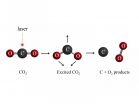Surfactants do not harm the environment
You can brush your teeth, and wash yourself and your clothes with a clear conscience; the most common soaps, shampoos and detergents actually pose a minimal risk to the environment
2014-10-03
(Press-News.org) When you take a shower and rinse the soap and shampoo off your body, the foam conveniently disappears between your toes and down the drain. Have you ever thought about what happens to the surfactants afterwards? Whether they seep into the groundwater, lakes and streams, where they could pose a risk to fish and frogs?
Not likely. This is shown in a new and very comprehensive report of the potential impact on the environment of the enormous amounts of common surfactants used day in and day out by consumers all over the world.
"We humans use several million tons of surfactants a year on a global scale. It amounts to billions of kilos, so these are substances that you really don't want to release into the environment unless you're thoroughly familiar with them," says senior researcher Hans Sanderson, Department of Environmental Science, Aarhus University, who is one of the authors of the report.
More Than 250 Studies
For the purpose of promoting the sustainable use of surfactants, the researchers analysed their findings regarding the use, disposal, treatment and risk to the aquatic environment of the most important surfactant ingredients in North America. Although the studies are based in North America, they nevertheless apply on a global scale because they are more or less identical all over the world.
The result is a 100-page virtually encyclopaedic list that sums up more than 250 scientific studies spanning forty to fifty years, at an overall cost of approximately USD 30 million.
"It's the most comprehensive and definitive report to date regarding the environmental properties of detergent substances in soap products – in other words, personal care and cleaning products," says Hans Sanderson.
Soap is Rapidly Degraded
The report shows that when the substances are used correctly and responsibly, and once they have been through a proper treatment plant, the risk to the surrounding environment is very low .
"The substances are made so that they degrade rapidly and thus don't pose a risk to the environment. I can't think of any other substances released into the environment in such large amounts via everyday use by all of us. It's the most commonly used substances of all that go directly into the wastewater, so it's important to keep track of them and ensure that there are no unpleasant surprises in the treatment plants or in the environment," says Hans Sanderson.
How Do Surfactants Work?
Surfactants have a special ability to dissolve fat while at the same time being water soluble. This is because they consist of components that have a hydrophilic head and a hydrophobic tail. The hydrophobic tails repel water but are fond of fat. This means that the tails are the ones that dissolve the fat when we wash ourselves with soap. The surfactant's hydrophilic heads ensure that the fat is carried away in the rinse water.
INFORMATION:
The article "Environmental safety of the use of major surfactant classes in North America" has been published in the scientific journal Critical Reviews in Environmental Science, which has a five-year Journal Impact Factor of 5.36. The article provides an overview of the use, fate, toxicity, environmental properties, chemical structure, and physical and chemical properties of surfactants.
[Attachments] See images for this press release:

ELSE PRESS RELEASES FROM THIS DATE:
2014-10-03
Microfluidic tools for precision measurements of cell migration speed reveal that migratory speed of individual cells changes stochastically from parent cells to their descendants, while the average speed of the cell population remains constant through successive generations.
A team of researchers at the Massachusetts General Hospital and Harvard Medical School in Boston has developed technologies for precision measurement of cell migration speed before and applied the new tool to study the variations of migration speed in population of cancer cells. This tool enabled ...
2014-10-03
Scientists at the University of Granada, in collaboration with La Paz University Hospital in Madrid and the University of Texas, San Antonio in the US have demonstrated through several experiments conducted on Zucker obese rats that chronic consumption of melatonine helps combat obesity and diabetes mellitus type two.
Their research has confirmed that chronic administration of melatonine in young obese rats with diabetes mellitus type two, similar to its human equivalent, improves mitochondrial dysfunction (i.e. mitochondrial homeostatic functions) in a very efficient ...
2014-10-03
Social network analysis could improve knowledge sharing in the healthcare sector, according to research results published in the International Journal of Collaborative Enterprise.
Elizabeth Cudney, Steven Corns and Suzanna Long in the department of Engineering Management and Systems Engineering at Missouri University of Science and Technology, in Rolla, Missouri, USA, explain how knowledge management systems (KMS) can be critical in capturing, retaining and communicating project results and staff knowledge. They can prevent knowledge drain and provide training as "lessons ...
2014-10-03
Researchers at the University of Granada have designed a new imaging system capable of obtaining up to twelve times more colour information than the human eye and conventional cameras, which implies a total of 36 colour channels. This important scientific development will facilitate the easy capture of multispectral images in real time, and in the not too distant future it could also be used to develop new asisted vehicle driving systems, identify counterfeit bills and documents or obtain medical images much more accurate than current ones, among many other applications.
The ...
2014-10-03
Many of those who are genetically predisposed to develop atrial fibrillation, which dramatically raises the risk of stroke, can be identified with a blood test. This is shown by new research from Lund University in Sweden.
The number of people affected by atrial fibrillation is rising rapidly, partly as a result of the ageing population.
Over recent years, a research group at Lund University in Sweden, working with other universities and hospitals in Europe and the USA, has identified twelve genetic variants in the human genome that increase the risk of atrial fibrillation. ...
2014-10-03
Johnny Depp has an unforgettable face. Tony Angelotti, his stunt double in "Pirates of the Caribbean," does not. So why is it that when they're swashbuckling on screen, audiences worldwide see them both as the same person? Scientists from the University of California, Berkeley, have cracked that mystery.
Researchers have pinpointed the brain mechanism by which we latch on to a particular face even when it changes. While it may seem as though our brain is tricking us into morphing, say, an actor with his stunt double, this "perceptual pull" is actually a survival mechanism, ...
2014-10-03
yphoon Phanfone's eye appeared the size of a pinhole on visible imagery from NASA's Aqua satellite on Oct.3.
The MODIS instrument or Moderate Resolution Imaging Spectroradiometer that flies aboard NASA's Aqua satellite captured a visible image of Phanfone moving through the Northwestern Pacific Ocean on Oct. 3 at 4:20 UTC (12:20 a.m. EDT). The tiny open eye of the storm was surrounded by a thick band of thunderstorms. The MODIS image also showed a very thick and large band of thunderstorms south of the center and spiraling into the eye.
On Thursday, Oct. 2, Typhoon ...
2014-10-03
VIDEO:
Mexico's western coast is again dealing with rain, wind and rough surf from another tropical storm. NOAA's GOES-West satellite saw the formation of Tropical Storm Simon on Oct. 2. A...
Click here for more information.
Mexico's western coast is again dealing with rain, wind and rough surf from another tropical storm. NOAA's GOES-West satellite saw the formation of Tropical Storm Simon on Oct. 2. A NASA animation of NOAA's GOES-West satellite imagery shows the development ...
2014-10-03
About one-fifth of the Earth's atmosphere is oxygen, pumped out by green plants as a result of photosynthesis and used by most living things on the planet to keep our metabolisms running. But before the first photosynthesizing organisms appeared about 2.4 billion years ago, the atmosphere likely contained mostly carbon dioxide, as is the case today on Mars and Venus.
Over the past 40 years, researchers have thought that there must have been a small amount of oxygen in the early atmosphere. Where did this abiotic ("non-life") oxygen come from? Oxygen reacts quite aggressively ...
2014-10-03
Curiosity helps us learn about a topic, and being in a curious state also helps the brain memorize unrelated information, according to researchers at the UC Davis Center for Neuroscience. Work published Oct. 2 in the journal Neuron provides insight into how piquing our curiosity changes our brains, and could help scientists find ways to enhance overall learning and memory in both healthy individuals and those with neurological conditions.
"Our findings potentially have far-reaching implications for the public because they reveal insights into how a form of intrinsic motivation ...
LAST 30 PRESS RELEASES:
[Press-News.org] Surfactants do not harm the environment
You can brush your teeth, and wash yourself and your clothes with a clear conscience; the most common soaps, shampoos and detergents actually pose a minimal risk to the environment






